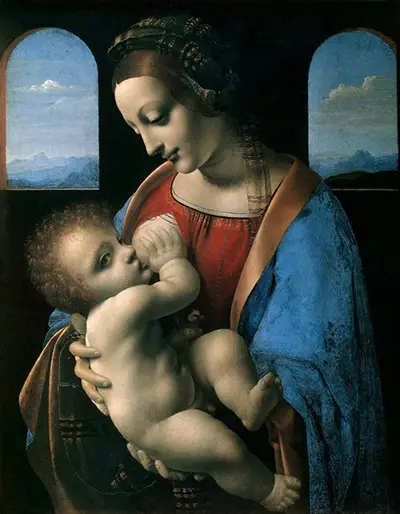It was produced in Milan, Italy, during the 1490s. Leonardo had moved to Milan from Florence in 1482. It is recognized as a pioneer of the upcoming new period in art, the High Renaissance.
It depicts a woman believed to be Mary, feeding a baby, who is perceived to be Jesus. Mary is gazing lovingly down at her baby as he breastfeeds.
Jesus on the other hand is looking towards the audience, with his eyelids seemingly heavy, perhaps because he has been breastfed enough and now feels full and sleepy. One striking feature in this artwork is in Mary's outfit.
It seems it was a feature during Renaissance Florence to make women's garments in such a way to facilitate breastfeeding.
The figures in the painting are set in a dark interior and two arched windows, which is a typical Leonardo style, such as the earlier Madonna of the carnation. In the background, there is a colourful mountainous landscape.
The Litta Madonna was named after the noble family in Milan, the Vicontis who owned it for centuries. While it is most generally appreciated as the work of Leonardo, some quarters point out that it may have been a collaboration with one of his pupils or entirely a product from his workshop.
One of the reasons these doubts emerge is that some aspects of the panting do not entirely portray aspects associated with most of the works produced by Leonardo da Vinci's. For example, Leonardo would use entirely dark backgrounds, which is not evident in this case, while the harsh outlines of the mother and baby Jesus has caused some to question whether it was the work of his workshop.
However, since the painting was done using the Tempera medium, instead of oil which Leonardo was used to working with, may be an explanation of the harsh outline.
In addition, the depiction of the infant and how he draws his portraits in three quarter views has all the trademarks of a typical Leonardo painting. Furthermore, the strong emotions portrayed by the mother and her child is typical of most Leonardo paintings such as the Mona Lisa, Madonna of the Rocks and St Jerome among others.
The tilt of Madonna's head is also a typical Leonardo signature. Experts who have closely examined the painting seem to come to the conclusion that Leonardo was involved in designing the pose and completed the head, while leaving one of his favourite students, probably Marco d'Oggiono or Giovanni Antonio Boltraffio, to complete it under his strict supervision.
After the Vicontis had owned the painting for centuries, they sold it to a Tsar, and then it changed hands to Emperor Alexander II. The painting was added to the Hermitage and transferred from wood to a canvas. It was repainted fully twice, and it is now housed in Saint Petersburg at the Hermitage Museum.


